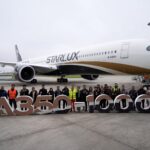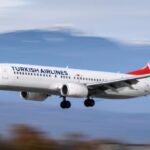For decades, aviation has been considered a male-dominated business, particularly in technical and leadership positions. Women have always been visible as cabin staff, but their representation in the cockpit, engineering hangars, and executive boardrooms has lacked. However, a slow but considerable transition is occurring. Airlines throughout the world are beginning to promote diversity and inclusion, seeing that a diverse staff not only represents modern society but also encourages innovation, efficiency, and consumer engagement.
Brussels Airlines is one such carrier taking steps towards improvements. The airline is setting an example for the industry by publicising the achievements of pioneering women in maintenance and engineering, as well as actively trying to boost gender representation within divides.

Brussels Airlines
Carolien Sterckx made history at Brussels Airlines two decades ago, becoming the carrier’s first fully licensed female technician in August 2005. At the time, she stood out in a male-dominated sector, breaking down barriers and challenging views of what women might do in aviation maintenance. Today, her narrative continues to inspire the next generation of women seeking technical careers. And, while she is no longer the only woman in the hangar she now works with 27 other female colleagues in the maintenance and engineering department the statistics continue to show the gender discrepancy. Women account for only 8% of the workforce at Brussels Airlines, indicating the need for more progress towards gender equality.
Looking at the airline as a whole, the situation appears more balanced at least on the surface. Women make up 52% of Brussels Airlines’ entire workforce and an astonishing 47% of top management roles, suggesting improvement in leadership diversity. Women dominate in several areas: ground operations staff is 76% female, while cabin crew is 72% female. However, other departments portray different. Women continue to be under-represented in technical and traditionally male-dominated fields, accounting for just 26% of the IT department, 10% of the cockpit crew, and 8% of maintenance duties. These data highlight both the successes and the challenges that remain in making aviation an industry in which women have equal opportunity at all levels.
Read more on: Women in Aviation – The Lack of Representation For Female Pilots And How The BWPA Is Combatting This In 2023

Global Landscape
Despite decades of discussion about diversity and inclusion, women continue to be significantly under-represented in technical and senior aviation professions, according to industry-wide data. Women make up just 5% of airline pilots and 3% of qualified aviation maintenance technicians worldwide.
According to The Guardian, the numbers in the United Kingdom are as poor. Female pilots make up only 6.5% of the field, and the gender wage gap remains a major issue. At certain airlines, the imbalance is more stark; Ryanair, for example, estimates a gender pay gap of up to 57.8%, highlighting the sector’s systemic disparities.

The airline industry is steadily evolving, but examples like Brussels Airlines’ provide promise. From one licensed technician in 2005 to over 30 now, progress is genuine, but so is the runway ahead.









